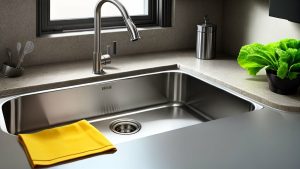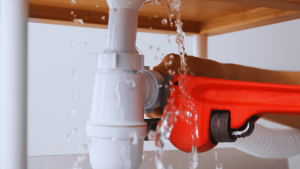If you’re looking to replace your kitchen faucet or fix a leak, you may be wondering how to tackle this project yourself. Fortunately, changing your kitchen faucet is a DIY task that anyone can accomplish with the right tools and guidance.
In this section, we’ll provide you with a step-by-step guide on how to change your kitchen faucet. From selecting the right faucet to troubleshooting any issues, we’ll cover all of the essential information you need to complete the job successfully, even if you’re a beginner.
Key Takeaways
- Changing your kitchen faucet is a DIY project that anyone can do.
- By following these easy steps, you can replace your kitchen faucet and improve both its functionality and overall appearance.
- Make sure you have the necessary tools and select the right faucet before beginning the project.
Tools Needed for Changing a Kitchen Faucet
Before you start the process of changing your kitchen faucet, you’ll need to make sure you have the proper tools. Having the right tools will help make the installation process go smoothly and ensure that you don’t damage any of the components in the process. Here are the essential tools you’ll need:
| Tool | Description |
|---|---|
| Adjustable Wrench | This tool is essential for disconnecting the water lines from the old faucet and connecting them to the new one. Make sure it’s large enough to fit the nuts on the water supply lines. |
| Basin Wrench | This tool is designed specifically for tightening and loosening nuts that are hard to reach in tight spaces such as under the sink. |
| Plumber’s Putty | This putty is used to create a seal between the base plate of the new faucet and the sink. It helps prevent water from leaking into the cabinet below. |
| Screwdriver | You’ll need a screwdriver to remove any screws that are holding the old faucet in place. A Phillips head screwdriver is the most common type needed. |
| Teflon Tape | This tape is used to wrap around the threads of the water supply lines to create a tight seal and prevent leaks. |
Having these tools handy before you start the project will make the process much smoother and ensure that you’re not stuck without the proper equipment halfway through the installation process.
Choosing the Right Kitchen Faucet
Replacing your kitchen faucet is an opportunity to not only fix a problem, but also to upgrade the look of your kitchen. Choosing the right faucet can have a significant impact on the functionality and overall appearance of your kitchen. Before you make a purchase, consider the following:
- Kitchen style: Choose a faucet that complements the design of your kitchen. A modern kitchen may benefit from a sleek, high-arc faucet with clean lines, while a traditional kitchen may look best with a more classic, low-arc faucet.
- Sink compatibility: Ensure that the faucet you choose is compatible with the number of holes in your sink. Some faucets require a single hole, while others may require up to four.
- Spout style: Consider the spout height and reach of the faucet. A high-arc spout provides more space for washing larger items, while a low-arc spout may be more suitable for a smaller sink.
- Finish: Choose a finish that matches your kitchen decor. Popular options include chrome, stainless steel, and brushed nickel.
- Price: Set a budget and stick to it. Prices of kitchen faucets vary greatly, so it’s important to choose one that meets your needs without breaking the bank.
By considering these factors, you can choose a kitchen faucet that not only looks great, but also functions properly in your kitchen. Keep in mind that a new faucet can drastically improve the look and feel of your kitchen, making it a worthwhile investment.
Removing the Old Kitchen Faucet
Before you can install your new kitchen faucet, you need to remove the old one. Here’s a step-by-step faucet installation guide to help you properly remove the old kitchen faucet:
- Prepare your workspace by clearing out any clutter and laying down a towel to protect the counter.
- Turn off the water supply valves located under the sink.
- Disconnect the water supply lines from the faucet by using an adjustable wrench to loosen the nuts that hold them in place.
- Remove the mounting nuts and washers that hold the faucet in place. These are typically located underneath the sink and may require a basin wrench to loosen them.
- Once you have removed the mounting nuts, lift the old faucet out of the sink.
- Remove any remaining caulking or debris from around the holes in the sink.
With the old faucet removed, you’re ready to move on to preparing the sink for the new faucet.
Preparing the Sink for the New Faucet
Now that you’ve successfully removed your old kitchen faucet, it’s time to prepare the sink for the new one. Follow these steps to ensure a smooth installation process:
- Remove any debris or old putty from the sink where the old faucet was installed. Use a putty knife to scrape away any excess material.
- Inspect the sink’s mounting holes, ensuring that they are clean and free of any debris. If there is any buildup around the holes, use a wire brush or scrubbing pad to remove it.
- Insert the gasket or mounting plate into the sink’s mounting holes. Some faucets may require specific gaskets or plates, so be sure to refer to the manufacturer’s instructions.
- Apply plumber’s putty around the base of the new faucet, ensuring that it covers the mounting holes and any gaps between the faucet and sink. Be careful not to apply too much putty, as excess putty can interfere with the faucet’s installation.
- Align the new faucet with the sink’s mounting holes and press down firmly on the base to secure the faucet in place.
- Attach the mounting hardware beneath the sink, tightening the nuts by hand. Use a wrench to tighten the nuts further, but be cautious not to over-tighten them, as this can damage the faucet or sink.
Once you’ve completed these steps, the sink should be ready for the new faucet. In the next section, we’ll guide you through the process of installing your new kitchen faucet.
Installing the New Kitchen Faucet
With the old faucet removed and the sink prepped for the new one, it’s time to install the new kitchen faucet. Follow these simple steps:
- Place the gasket and faucet plate onto the sink and align the faucet holes with the sink holes.
- From under the sink, insert the mounting screws and tighten them using a wrench or pliers.
- Attach the water supply lines to the respective hot and cold faucet handles. Make sure to tighten the connections using adjustable pliers.
- Attach the sprayer hose (if applicable) to the faucet and tighten it with pliers.
- Turn on the water supply valves and check for any leaks. If everything is working well, you’re all set!
By following these steps, you can successfully complete your kitchen faucet replacement and enjoy a fully functional new faucet. Remember, if you ever need help, don’t hesitate to call a professional plumber to assist you.
Troubleshooting Leaking Kitchen Faucet
Even with proper installation, you may encounter a leaking kitchen faucet. Here are some common problems you may encounter and how to fix them:
| Problem | Solution |
|---|---|
| The faucet drips even when the handle is turned off | This could be a result of worn out O-rings or a damaged valve seat. Disassemble the faucet and replace the O-rings or the valve seat. |
| Low water pressure | The aerator could be clogged with debris or mineral buildup. Remove the aerator and clean it with a brush or replace the aerator. |
| The faucet handle is difficult to turn | This could be a result of a worn out or damaged cartridge. Disassemble the faucet and replace the cartridge. |
| The faucet leaks at the base | This could be a result of a loose or worn out mounting nut. Tighten or replace the mounting nut. |
If you encounter a problem that you are not confident in fixing, consult a professional plumber to avoid causing more damage to the faucet or sink.
Maintenance and Care for Your Kitchen Faucet
Proper maintenance and care of your kitchen faucet can extend its lifespan and keep it functioning optimally for years to come. Here are some tips to help you care for your kitchen faucet:
1. Clean Your Faucet Regularly
Regular cleaning is essential for keeping your kitchen faucet in top condition. Use a gentle, non-abrasive cleaner and a soft cloth or sponge to wipe down your faucet regularly. Avoid using abrasive cleaners or scrubbers, as these can scratch the surface of your faucet and damage its finish.
2. Check for Leaks
Periodically check your faucet for leaks or drips. If you notice any leaks, address them promptly to prevent further damage to your faucet or sink. Usually, leaks can be resolved by tightening loose connections or replacing worn-out parts.
3. Maintain Your Water Pressure
Low water pressure can be frustrating and can also indicate a problem with your faucet or plumbing system. To maintain proper water pressure, clean your faucet’s aerator regularly to remove any buildup that may be obstructing the flow of water.
4. Prevent Mineral Buildup
Mineral buildup can cause your faucet to become clogged and function poorly. To prevent mineral buildup, wipe down your faucet regularly with a soft cloth and a solution of equal parts water and white vinegar. This will help dissolve any mineral buildup and keep your faucet functioning properly.
5. Address Hard Water Issues
If you have hard water, it can cause mineral buildup and other issues that can impact the performance of your faucet. Consider installing a water softener to reduce the hardness of your water and prevent damage to your faucet and plumbing system.
Upgrading Your Kitchen Faucet: Tips and Considerations
If you’re looking to upgrade your kitchen faucet, there are several factors to consider before making your final decision. The right faucet not only enhances your kitchen’s aesthetic appeal but also improves functionality. Here are some tips to help you choose the perfect faucet for your kitchen.
Consider Your Sink’s Compatibility
Before purchasing a new kitchen faucet, it’s important to consider the compatibility with your sink. The number of holes in your sink will determine the type of faucet you can install. Make sure the new faucet matches the existing holes in your sink or consider purchasing a sink deck plate to cover any unused holes.
Choose the Right Type of Faucet
There are several types of faucets to choose from, including pull-down, pull-out, and single-handle faucets. Consider your kitchen needs and choose a faucet that suits your lifestyle. For example, a pull-down faucet is more convenient for those who frequently wash large pots and pans.
Finish and Style
The finish and style of your faucet are equally important as functionality. Choose a finish that matches your kitchen’s hardware and complements the sink. Popular options include chrome, stainless steel, and brushed nickel. Additionally, choose a style that matches your kitchen’s overall design, such as modern or traditional.
Brand and Quality
Invest in a quality faucet from a reputable brand. A high-quality faucet will last longer, require less maintenance, and provide better performance. Consider brands such as Kohler, Delta, and Moen for their durability and reliability.
- Consider your sink’s compatibility before purchasing a new faucet.
- Choose a faucet type that suits your lifestyle.
- Match the faucet’s finish and style to your kitchen’s hardware and design.
- Invest in a high-quality faucet from a reputable brand.
Conclusion: Enhance Your Kitchen’s Functionality and Image
Changing your kitchen faucet doesn’t have to be a daunting task. With this step-by-step faucet installation guide, you can easily replace your old faucet with a new one and enhance your kitchen’s functionality and image.
By following the instructions provided in this article, you can successfully accomplish the DIY faucet replacement project. Remember to gather all the necessary tools before beginning the process, and choose the right faucet that fits your kitchen’s aesthetics and functionality needs.
Regular maintenance and care can keep your kitchen faucet in optimal working condition. Simple steps like cleaning the faucet regularly, fixing minor issues promptly, and checking for leaks can prevent major problems in the future.
Upgrade Your Kitchen Faucet with Confidence
If you’re considering upgrading your kitchen faucet, this guide offers helpful tips and considerations. Take the time to research different options and choose a faucet that complements your kitchen’s design and meets your functional requirements.
Don’t hesitate to tackle the kitchen faucet replacement project. With a few simple steps, you can change your faucet and enjoy the benefits it brings.
Thank you for reading!
FAQ
Q: What are the steps to change a kitchen faucet?
A: The steps to change a kitchen faucet are as follows:
1. Turn off the water supply.
2. Disconnect the supply lines.
3. Remove the old faucet.
4. Clean the sink surface.
5. Install the new faucet.
6. Connect the supply lines.
7. Turn on the water supply and check for leaks.
Q: What tools do I need to change a kitchen faucet?
A: To change a kitchen faucet, you will need the following tools:
1. Adjustable wrench
2. Plumber’s tape
3. Screwdriver
4. Basin wrench
5. Bucket or towel to catch water
Q: How do I choose the right kitchen faucet?
A: When choosing a kitchen faucet, consider the following factors:
1. Style and design
2. Functionality and features
3. Installation requirements
4. Quality and durability
5. Budget
6. Compatibility with your sink
Q: How do I remove the old kitchen faucet?
A: To remove the old kitchen faucet, follow these steps:
1. Turn off the water supply.
2. Disconnect the supply lines.
3. Unscrew the mounting nuts.
4. Remove the old faucet from the sink.
Q: How do I prepare the sink for the new faucet?
A: To prepare the sink for the new faucet, do the following:
1. Clean the sink surface.
2. Apply plumber’s tape to the faucet connections.
3. Position any gaskets or washers as instructed by the manufacturer.
Q: How do I install the new kitchen faucet?
A: To install the new kitchen faucet, follow these steps:
1. Position the new faucet into the mounting holes.
2. Secure the faucet with mounting nuts or screws.
3. Connect the supply lines.
4. Turn on the water supply and check for leaks.
Q: How do I troubleshoot a leaking kitchen faucet?
A: If you encounter a leaking kitchen faucet, try these troubleshooting steps:
1. Check and tighten all connections.
2. Replace worn-out gaskets or washers.
3. Clean or replace the cartridge or valve.
4. Inspect the supply lines for leaks or damage.
5. If necessary, seek professional assistance.
Q: How do I maintain and care for my kitchen faucet?
A: To maintain and care for your kitchen faucet, consider these tips:
1. Clean the faucet regularly using mild soap and water.
2. Avoid using harsh chemicals or abrasive cleaners.
3. Check for leaks and fix any issues promptly.
4. Lubricate moving parts if necessary.
5. Keep the faucet aerator clean and unclogged.
Q: What should I consider when upgrading my kitchen faucet?
A: When upgrading your kitchen faucet, think about the following:
1. Style and design that complements your kitchen.
2. Functionality and features that meet your needs.
3. Compatibility with your sink and existing plumbing.
4. Quality and durability for long-term use.
5. Budget and value for money.

It’s me, Amber Hayden, the heart and soul behind SagarmathaOnlineMedia.com. From a young age, I’ve been head over heels for everything home-related, from interior decor to gardening. I’m the type who can’t resist a well-crafted piece of furniture, and I firmly believe that a home isn’t complete without a pet or two. But it’s not just about creating pretty spaces for me. I’m all about making homes that tell a story reflecting the people living there. SagarmathaOnlineMedia.com is my way of sharing this passion with you. Whether you’re looking for tips to jazz up your living room, advice on pet care, or ideas to make your garden bloom, I’m here to help. So, let’s embark on this journey together and make your house a home!



